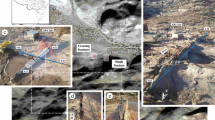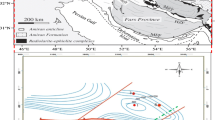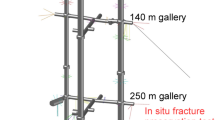Abstract
Fractures play an important role in controlling the hydraulic conductivity of rock masses, and the aperture significantly influences the magnitude of fracture seepage. In this study, field measurements and experiments were conducted at a well-exposed granite fracture site in the Beishan area, China. Several types of single natural fractures were selected to remove the weathered surface and expose the fresh fractures. Subsequently, measuring ruler dispersion-tangent middle axis (MRD-TMA) method was developed to measure the fracture aperture and capture fracture geometry. Then, electrical resistivity tomography (ERT) technique was employed to investigate the seepage properties of these fractures. The results reveal that MRD-TMA method achieved good flexibility and accuracy in the current measurement of fracture aperture, and ERT is a useful tool for detecting the seepage properties of fractures in hard rock masses. Combined with field observations, the filling form of fractures can be categorized according to the ERT inversion results, as follows: open-weak filling, open filling, loose filling, and fully cemented-closed form, whose seepage properties decrease as the filling density increases. Generally, the open-weak filling is the main water channel in a fracture network, while the fully cemented-closed type is a water-blocking fracture and typically exhibits a pseudo-fracture with a large surface opening. In summary, the method for obtaining the morphological characteristics of the aperture can provide a low-cost and time-efficient approach for fracture logging in the field, and ERT technique provides a reference for the detection of potential hazards caused by connected water-conducting fractures in rock engineering.













Similar content being viewed by others
References
Ali H, Kurokawa H, Uesugi K (2014) Camera based precision measurement in improving measurement accuracy. Measurement 49:38–147
Azimian A, Ajalloeian R (2015) Permeability and groutability appraisal of the Nargesi dam site in Iran based on the secondary permeability index, joint hydraulic aperture and Lugeon tests. Bull Eng Geol Environ 74:845–859
Baek SH, Kim SS, Kwon JS, Um ES (2017) Ground penetrating radar for fracture mapping in underground hazardous waste disposal sites: a case study from an underground research tunnel, south Korea. J Appl Geophys 141:24–33
Banerjee S, Chakraborti PC, Saha SK (2019) An automated methodology for grain segmentation and grain size measurement from optical micrographs. Measurement 140:142–150
Basu A, Celestino TB, Bortolucci AA (2009) Evaluation of rock mechanical behaviors under uniaxial compression with reference to assessed weathering grades. Rock Mech Rock Eng 42:73–93
Bellanova J, Calamita G, Giocoli A, Luongo R, Macchiato M et al (2018) Electrical resistivity imaging for the characterization of the Montaguto landslide (southern Italy). Eng Geol 243:272–281
Bharti AK, Prakash A, Verma A, Singh KKK (2021) Assessment of hydrological condition in strata associated with old mine working during and post-monsoon using electrical resistivity tomography: a case study. Bull Eng Geol Environ 80:5159–5166
Brown SR, Kranz RL, Bonner BP (1986) Correlation between the surfaces of natural rock joints. Geophys Res Lett 13:1430–1433
Chen L, Wang J, Zong ZH, Liu J et al (2015) A new rock mass classification system QHLW for high-level radioactive waste disposal. Eng Geol 190:33–51
Detwiler RL, Pringle SE, Glass RJ (1999) Measurement of fracture aperture fields using transmitted light: an evaluation of measurement errors and their influence on simulations of flow and transport through a single fracture. Water Resour Res 35:2605–2617
Fernlund JMR (2005) Image analysis method for determining 3-D size distribution of coarse aggregates. Bull Eng Geol Environ 64:159–166
Geet MV, Swennen R (2001) Quantitative 3D-fracture analysis by means of microfocus X-ray computer tomography (μCT): an example from coal. Geophys Res Lett 28:3333–3336
Gentier S, Billaux L, Vliet L (1989) Laboratory testing of the voids of a fracture. Rock Mech Rock Eng 22:149–157
Guo L, Li XZ, Zhou YY, Zhang YS (2015) Generation and verification of three-dimensional network of fractured rock masses stochastic discontinuities based on digitalization. Environ Earth Sci 73:7075–7088
Hooker JN, Laubach SE, Marrett R (2013) Fracture-aperture size frequency, spatial distribution, and growth processes in strata-bounded and non-strata-bounded fractures, Cambrian Mesón Group, NW Argentina. J Struct Geol 54:54–71
Hoorde MV, Hermans T, Dumont G, Nguyen F (2017) 3D electrical resistivity tomography of karstified formations using cross-line measurements. Eng Geol 220:123–132
Huang N, Jiang YJ, Liu RC, Li B, Sugimoto S (2019) A novel three-dimensional discrete fracture network model for investigating the role of aperture heterogeneity on fluid flow through fractured rock masses. Int J Rock Mech 116:25–37
Huo D, Pini R, Benson SM (2016) A calibration-free approach for measuring fracture aperture distributions using X-ray computed tomography. Geosphere 12:558–571
Karimpouli S, Tahmasebi P, Ramandi HL, Mostaghimi P, Saadatfar M (2017) Stochastic modeling of coal fracture network by direct use of micro-computed tomography images. Int J Coal Geol 179:153–163
Kemna A, Vanderborght J, Kulessa B, Vereecken H (2002) Imaging and characterisation of subsurface solute transport using electrical resistivity tomography (ERT) and equivalent transport models. J Hydrol 267:125–146
Ketcham RA, Mote AS (2019) Accurate measurement of small features in X-ray CT data volumes, demonstrated using gold grain. J Geophys Res, Solid Earth 124:3508–3529
Li G, Liu QW, Zhao, SM, Qiao WT, Ren XL (2020) Automatic crack recognition for concrete bridges using a fully convolutional neural network and naive bayes data fusion based on a visual detection system. Meas Sci Technol 31:075403. https://doi.org/10.1088/1361-6501/ab79c8
Liu Y, Wang Q, Chen JP, Han XD, Song SY, Ruan YK (2021) Investigation of geometrical representative elementary volumes based on sampling directions and fracture sets. Bull Eng Geol Environ 80:2171–2187
Loke MH, Barker RD (1995) Least-squares deconvolution of apparent resistivity pseudosections. Geophysics 60:1682–1690
Mazumder S, Wolf KHAA, Elewaut K, Ephraim R (2006) Application of X-ray computed tomography for analyzing cleat spacing and cleat aperture in coal samples. Int J Coal Geol 68:205–222
Montero R, Menendez E, Victores JG (2017) Balaguer C (2017) Intelligent robotic system for autonomous crack detection and caracterization in concrete tunnels. IEEE International Conference on Autonomous Robot Systems and Competitions 4:316–321
Nijland N, Meijde M, Addink EA, Jong SMD (2010) Detection of soil moisture and vegetation water abstraction in a Mediterranean natural area using electrical resistivity tomography. CATENA 81:209–216
Priest SD (1993) Discontinuity analysis for rock engineering. Chapman and Hall, London
Ramandi HL, Armstrong RT, Mostaghimi P (2016) Micro-CT image calibration to improve fracture aperture measurement. Nondestruct Test Eva 6:4–13
Ramandi HL, Mostaghimi P, Armstrong RT (2017) Digital rock analysis for accurate prediction of fractured media permeability. J Hydrol 554:817–826
Ravindran AA, Mondal NC, Ramanujam N, Srinivasamoorthy K, Anbazhagan P (2016) Appraisal of groundwater resource in holocene soil deposits by resistivity, hydrochemical and granulomerial studies in the gulf of mannar coast from southern India. Environ Earth Sci 75:166. https://doi.org/10.1007/s12665-015-4883-8
Renshaw CE, Dadakis JS, Brown SR (2000) Measuring fracture apertures: a comparison of methods. Geophys Res Lett 27:289–292
Schlüter S, Sheppard A, Brown K, Wildenschild D (2014) Image processing of multiphase images obtained via X-ray microtomography: a review. Water Resour Res 50:3615–3639
Singh HK, Basu A (2018) Evaluation of existing criteria in estimating shear strength of natural rock discontinuities. Eng Geol 232:171–181
Wang J (2010) High-level radioactive waste disposal in China: update 2010. J Rock Mech Geotech 2:1–11
Wang J, Chen L, Su R, Zhang XG (2018) The beishan underground research laboratory for geological disposal of high-level radioactive waste in china: planning, site selection, site characterization and in situ tests. J Rock Mech Geotech 10:411–435
Wang W (2006) Image analysis of particles by modified Ferret method—best-fit rectangle. Powder Technol 165:1–10
Wu Y, Huang Z, Zhao K, Zeng W, Gu Q, Zhang R (2020) Unsteady seepage solutions for hydraulic fracturing around vertical wellbores in hydrocarbon reservoirs. Int J Hydrog Energy 45:9496–9503
Xiong XB, Li B, Jiang YJ, Koyama T, Zhang CH (2011) Experimental and numerical study of the geometrical and hydraulic characteristics of a single rock fracture during shear. Int J Rock Mech Min 48:1292–1302
Xu WT, Zhang YS, Li XZ, Wang XY et al (2021) Comprehensive identification of statistical homogeneity of fractured rock masses for a candidate HLW repository site, China. Eng Geol 293:106279. https://doi.org/10.1016/j.enggeo.2021.106279
Xu WT, Zhang YS, Li XZ, Wang XY et al (2020) Extraction and statistics of discontinuity orientation and trace length from typical fractured rock mass: A case study of the Xinchang underground research laboratory site, China. Eng Geol 269:105553. https://doi.org/10.1016/j.enggeo.2020.105553
Xu WT, Zhang YS, Li XZ, Wang XY, Zhang PX (2019) Study on three-dimensional fracture network connectivity path of rock mass and seepage characteristics based on equivalent pipe network. Environ Earth Sci 78:516. https://doi.org/10.1007/s12665-019-8505-8
Yasuhara H, Polak A, Mitani Y, Grader AS, Halleck PM, Elsworth D (2006) Evolution of fracture seepage through fluid–rock reaction under hydrothermal conditions. Earth Planet Sci Lett 244:186–200
Yu SN, Jang JH, Han CS (2007) Auto inspection system using a mobile robot for detecting concrete cracks in a tunnel. Automat Constr 16:255–261
Zhang PX, Li XZ, Huang Z, Zhang YS, Yao XH (2019) Influence of fault zone on the respect distance and margin for excavation: a case study of the F4 fault in the Jijicao rock block, China. Bull Eng Geol Environ 78:2653–2669
Zhang QG, Ju Y, Gong WB, Zhang L, Sun HF (2015) Numerical simulations of seepage flow in rough single rock fractures. Petroleum 1:200–205
Zhang ZL, Yang JG, Ding LH, Zhao YM (2012) Estimation of coal particle size distribution by image segmentation. Int J Min Sci Techno 5:130–135
Zhou QY, Shimada J, Sato A (2001) Three-dimensional spatial and temporal monitoring of soil water content using electrical resistivity tomography. Water Resour Res 37:273–285
Funding
The authors received support from the National Key Research and Development Project of High-level Radioactive Waste Disposal of China (No. [2012]491; No. [2015]297; No. [2020]194) and the Nanjing University Innovation Program for PhD candidate (CXYJ21-47). This project also received support from the Beijing Research Institute of Uranium Geology.
Author information
Authors and Affiliations
Corresponding authors
Rights and permissions
About this article
Cite this article
Xu, W., Li, X., Zhang, Y. et al. Aperture measurements and seepage properties of typical single natural fractures. Bull Eng Geol Environ 80, 8043–8058 (2021). https://doi.org/10.1007/s10064-021-02392-2
Received:
Accepted:
Published:
Issue Date:
DOI: https://doi.org/10.1007/s10064-021-02392-2




